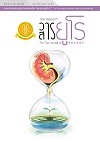Comparative Analysis of the Efficacy and Safety of Transurethral Vaporization and Transurethral Resection of the Prostate in Saline
Keywords:
BPH, transurethral vaporization, transurethral resection of the prostate, ต่อมลูกหมากโต, การผ่าตัดด้วยวิธีทำให้ระเหิดด้วยไฟฟ้า, การผ่าตัดโดยการตัดด้วยไฟฟ้าAbstract
Objective: To compare the efficacy and safety of transurethral resection of the prostate in saline (TURiS) and TURIS-plasma vaporization (TURIS-V) for treatment of BPH.
Material and Methods: A prospective randomized study was performed to compare the short-term outcomes of TURiS and TURIS - V in BPH patients; there were 15 patients in each group. All patients were assessed preoperatively and followed up at 1 month postoperatively. Patient baseline characteristics, perioperative data, and postoperative outcomes such as IPSS scores, Quality of life (Qol), maximal urine flow rate (Q max), and hospital stay were compared. Major complications were recorded.
Results: There was no significant difference between the 2 groups in mean age, prostate volume, and PSA level. The mean operative times were 49 minutes in the TURiS group and 32 minutes in the TURIS - V group. TURIS - V groups had significantly shorter operative times than the TURiS groups (p<0.05). TURiS - V groups had significantly decreased irrigation fluid volume during the operation in comparison with the TURiS group (p<0.05). There was no statistically significant difference in post-operative irrigation fluid and catheter time in the 2 groups. There was one episode of clot retention and one blood transfusion in the TURiS group, and one episode of clot retention and two blood transfusions in the TURIS - V group.
Conclusion: TRIS-V showed good efficacy, reduced operative time, and decreased irrigation fluid during the operation compared with TURi S. TURIS-V was an effective surgical treatments for BPH in addition to conventional TURiS. Long- term follow- ups are required.
การศึกษาประสิทธิภาพการผ่าตัดต่อมลูกหมากโตโดยใช้ไฟฟ้าระเหิดต่อมลูกหมาก เปรียบเทียบกับการผ่าตัดต่อมลูกหมากโตโดยการใช้ไฟฟ้า
ชวินท์ สุขะพิริยะ
หน่วยศัลยกรรม โรงพยาบาลกลาง
บทคัดย่อ
วัตถุประสงค์: เพื่อศึกษาประสิทธิภาพและผลของการรักษาต่อมลูกหมากโตโดยการผ่าตัดด้วยวิธีการทำให้ระเหิดด้วยไฟฟ้าเปรียบเทียบกับการผ่าตัดต่อมลูกหมากโตโดยการตัดด้วยไฟฟ้า
ผู้ป่วยและวิธีการศึกษา: ทำการศึกษาในผู้ป่วยต่อมลูกหมากโต 30 ราย โดยแบ่งผู้ป่วยเป็น 2 กลุ่มด้วยวิธีการสุ่มตัวอย่างแบ่งผู้ป่วยออกเป็นกลุ่มละ 15 คนกลุ่มแรกทำการผ่าตัดต่อมลูกหมากโตโดยการผ่าตัดด้วยไฟฟ้า กลุ่มที่สองทำการผ่าตัดต่อมลูกหมากโตโดยการระเหิดด้วยไฟฟ้า ศึกษาเปรียบเทียบด้วย อายุผู้ป่วยขนาดต่อมลูกหมาก IPSS score ก่อน และหลังการผ่าตัด 1 เดือน ระยะเวลาในการผ่าตัด ปริมาณสายน้ำที่ใช้ระหว่างผ่าตัดระยะเวลาในการใส่สายปัสสาวะ ระยะเวลาในการนอนโรงพยาบาล และภาวะแทรกซ้อนหลังการผ่าตัด ทั้งสองกลุ่ม
ผลการศึกษา: ไม่พบความแตกต่างในอายุของผู้ป่วย ขนาดต่อมลูกหมาก และ serum PSA ในทั้งสองกลุ่มอย่างมีนัยสำคัญทางสถิติ ขนาดต่อมลูกหมากในกลุ่มที่ผ่าตัดต่อมลูกหมากโตโดยวิธีการระเหิด ขนาดเล็กกว่า กลุ่มที่ทำการผ่าตัดต่อมลูกหมากโตโดยวิธีการตัดต่อมลูกหมากโตด้วยไฟฟ้า ระยะเวลาที่ใช้ในการผ่าตัด และสารน้ำใช้ในระหว่างการผ่าตัดของกลุ่มที่ผ่าตัดต่อมลูกหมากโตด้วยวิธีการระเหิดน้อยกว่าอีกกลุ่มอย่างมีนัยสำคัญทางสถิติ ปริมาณสารน้ำเกลือที่ใช้หลังการผ่าตัด และระยะเวลาใส่สายสวนปัสสาวะหลังการผ่าตัดไม่แตกต่างกันอย่างมีนัยสำคัญทางสถิติ ในกลุ่มผ่าตัดต่อมลูกหมากโตโดยวิธีการระเหิดพบภาวะแทรกซ้อน เลือดอุดตันในสายสวนปัสสาวะ 2 รายและต้องได้รับเลือดทดแทน 1 รายในกลุ่มผ่าตัดต่อมลูกหมากโตโดยการใช้ไฟฟ้าตัด พบ เลือดอุดตันในสายสวนปัสสาวะ 1 ราย และต้องได้รับเลือดทดแทน 2 ราย
สรุป: การผ่าตัดต่อมลูกหมากโตโดยวิธีการระเหิด ช่วยลดระยะเวลาในการผ่าตัด และการใช้สารน้ำระหว่างการผ่าตัดเมื่อเปรียบเทียบกับการผ่าตัดต่อมลูกหมากโตโดยการใช้ไฟฟ้าตัด


